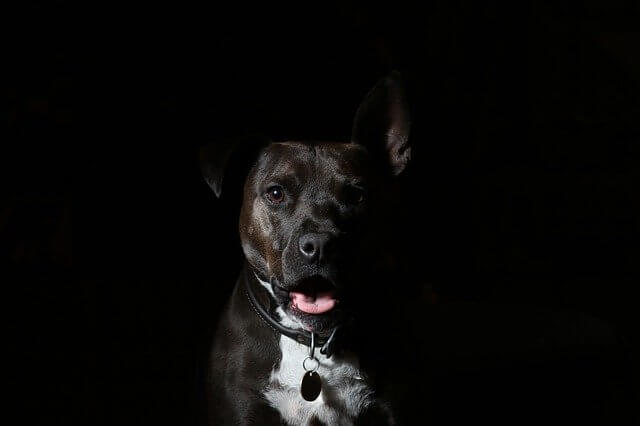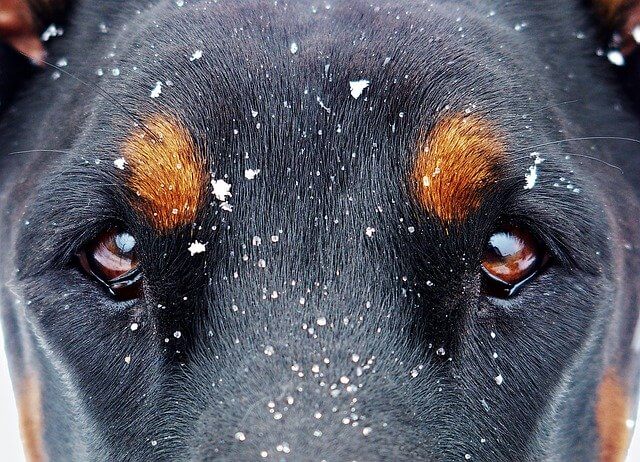It is not a surprising fact that a dog sees the world very differently to us, humans. It is essential to be aware of this so that we can understand and predict our pet dogs’ behaviours in the human world.
In this article, we will explore one of the most interesting questions – How far can a dog see?
Namely, we will discuss the following topics:
- What Is a dog’s field of vision?
- How well do dogs see at night?
- How do dogs see colour?
- What is a sighthound?
- Things your dog can see that you can’t
Let’s get started!
How far can a dog see: The Distance
You might be surprised to find out that the dog’s vision is not that good when it comes to a distance.
It’s important to mention that, on the contrary to humans that rely mainly on their vision, dogs use their senses in the following order:
- Scent,
- Hearing,
- Sight.
Therefore, a dog can be unsure when it hears his owner’s voice and does not entirely rely on his vision or hearing faculty until the human is close enough to scent.
The sight distance of a dog is usually 40 meters on average.
However, the image will appear blurred, and all three canine’s sensory faculties will have to confirm it.
A dog can see the object clearly from 20 feet or 6 meters away. On the other hand, the human will be able to see the same thing from 75 feet (23 meters) away.
At a further distance, the object will appear blurred to an eye.
That is to say, contrary to the common belief, the dogs’ visual acuity is actually worse than human’s.
How Far Can A Dog See: Dog’s Field Of Vision

Have you ever taken your dog to a puppy socialisation class? One of the things that you may have heard mentioned there is how your dog’s field of vision is different to your own and why it is so important to be aware of this, especially when your dog is young.
When answering the question,- How far can a dog see, we shouldn’t forget one crucial point. A dog’s field of vision is much broader than a human’s.
It means that your dog is aware of approaching scenarios before they have even begun to play out.
For example, a puppy has already clocked onto a human child eyeballing it from the other side of the park. So the levels of excitement or anxiety have been building up way longer than you are aware of by the time the child is up close wanted to pet it.
You might not aware of the child approaching until it has already reached out to touch. Contrariwise, your pup might already be trying to wriggle away, or may even snap at the child to warn them off. Most young children don’t know the correct way to say hello to a dog, which can put a lot of stress on the animal.
Remember also that your dog’s eyes are placed on the side of its head, giving it a visual field of 250 degrees.
Namely, dogs have 60 degrees more peripheral vision than humans. Dogs can, therefore, see much more than us without having to turn their heads.
It also means that their binocular or central vision is less than ours, approximately half of a human’s, in fact. It makes our ability to judge the distance of an object by sight much better than our furry friends.
How Far Can A Dog See At Night?

Next, you might be wondering, how far can a dog see in the darkness?
Dogs have more light receptors than humans. As a result, they find it easier to see in lower light conditions than we do.
You may also have noticed that your dog’s pupil is massive in comparison to your own. Because of this, a dog’s eye allows more light to enter, helping them to see more clearly in the dark.
Have you ever wondered why your dog’s eyes glow in the dark? Dogs possess something called a Tapetum at the back of the eye, which is a mirror-like structure that reflects light.
Because of this structure, light waves bounce back against the retina twice, giving it even more opportunity to collect light. The Tapetum causes your dog’s eyes to glow.
Have you ever taken a picture of your dog with a flash when he is looking directly at the camera and found that his eyes glow blue in photos? Now you know that it is the Tapetum that is responsible for this!
Humans get red-eye in similar photo situation because the light is reflected off the blood vessels in the back of their eyes.
How Do Dogs See Colour?
Now, when we have answered the question of how far can a dog see in general, let’s discuss how do dogs see colours.
Everybody thinks that dogs are colour-blind, but this isn’t technically true. The fact is that dogs do see colour, but they see it less strongly than we do.
Therefore they experience a more muted world to the vivid coloured world of most humans. The reason for this is that we have more colour receptors in our eyes.
Humans are actually five times more receptive to colours than dogs in the area where the eye focuses best. It is due to the fact that we possess a central retina area than contains 100% cones in comparison to a dog that posses only 20%.
Dogs only have two kinds of colour receptors, whereas humans have three. Our vision is trichromatic, meaning that our cones come in three colours: red, green, and blur-violet.
Dog vision is dichromatic, meaning they have two coloured cones. It is the reason why dogs can distinguish best between blue and yellow. Hence, many dog toys and agility obstacles are designed with this in mind.
What Is A Sighthound?
Sighthounds, also called gazehounds, are dogs that primarily hunt by sight and speed as opposed to smell and endurance.
There are different dog breeds in this category, including whippets, Salukis, greyhounds, lurchers, and more. A dog like a whippet can see quite far to compare to other hunting dogs as labrador, for instance.
If you live with a sighthound dog, you must be even more aware of their increased field of vision. They also have an instinct to chase after anything that resembles prey, that they will often spot from a far distance.
Once a sighthound is in hunting mode and has clocked onto its perceived prey, far in the distance, you will have difficulty controlling its desire to sprint off into the sunset.
These dogs can reach speeds of 40 miles per hour and more, very quickly. Once their sights are locked onto their prey, and they have started chasing, they also can lock off other senses, like their hearing.
This way, they can put all of their energy into the task at hand. It makes it futile to call your sighthound dog back to you because they probably can’t hear you.
Things Your Dog Can See That You Can’t

To end the article, here is a fun round-up of things your dog can see that you can’t!
Ultraviolet and black light – This means they can see everything you can see, and a whole lot more!
Layers in paint – Your lucky dog gets more in-depth insight into an artist’s process! It is because he can see every mistake and change of heart in the various layers of paint put down on a canvas.
More of the night sky – You would have to drive out to the countryside to see more stars in the sky. However, your dog can see them from the middle of a light-polluted city.
Human teeth – Okay, we can see our teeth too! But, if you use a lot of fluoride-based products, then to your dog, you look like a Cheshire cat with glowing teeth!
Pee marks – Not only can your dog smell pee, but they can also see it the dried residue left behind if it hasn’t been cleaned properly.
The earth’s magnetic field – This is such a cool fact! Did you know that every time your dog pees, he aligns himself with the north-south axis because he can actually see the earth’s magnetic field?
How Far Can A Dog See: Conclusion
So there you have it, not only have you found more out about how far a dog can see; but you now also know about how they see things, how well they see things, and what they can actually see in comparison to us.
I bet you’ll never look at your dog in the same way again. Our pet dogs are fascinating creatures, with amazing capabilities, even though it seems that all they do is sleep, eat, run about, and relieve themselves.
If you enjoyed this article, you might also like our review: “How far can a dog hear”.



Comments
Very educational
Thank you, we appreciate you feedback!
how far can a dog eye can see
Hi Savvas, a dog can see an object clearly from around 6 metres away. The sight distance of a dog is 40 metres on average, but the image will appear blurred, and other canine’s sensory faculties will have to confirm it.